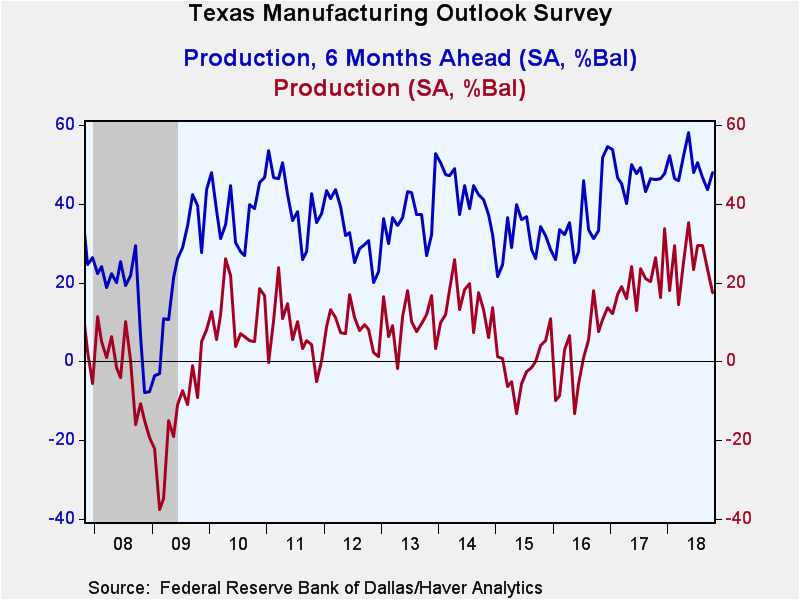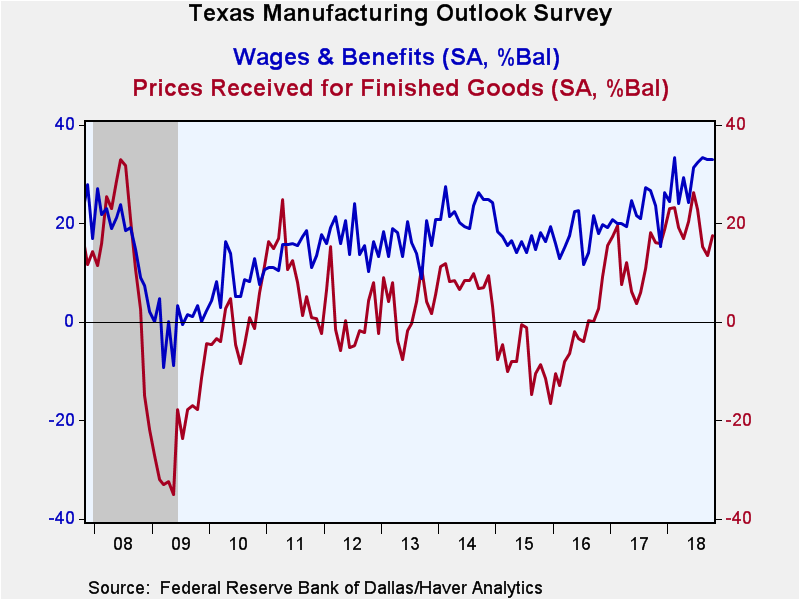 Global| Oct 29 2018
Global| Oct 29 2018Texas Factory Sector Index Improves but Expectations Ease
by:Tom Moeller
|in:Economy in Brief
Summary
The Federal Reserve Bank of Dallas indicated in its Texas Manufacturing Outlook Survey that the General Business Activity Index rose to 29.4 during October and recovered most of its September decline. Nevertheless, the index has moved [...]
The Federal Reserve Bank of Dallas indicated in its Texas Manufacturing Outlook Survey that the General Business Activity Index rose to 29.4 during October and recovered most of its September decline. Nevertheless, the index has moved erratically sideways for more than a year.
Movement amongst the sub-series was mixed last month. The employment, unfilled orders and delivery times readings improved. The shipments, production and hours-worked readings, however, declined sharply. Other component readings held fairly steady. The capital expenditures reading recovered most of its sharp decline during the prior month.
The index for finished goods prices received rose but remained well below its June high. The raw materials price measure recovered its September decline and rose to the highest level since 2011.
The index of expected business conditions in six months improved m/m, but continued on its sideways trend of the last two years. Movement amongst the sub-series remained mixed. Expected production, shipments and hours-worked rose, but the expected employment, wages & benefits and unfilled orders declined. The future capital expenditures reading fell sharply.
Each index is calculated by subtracting the percentage reporting a decrease from the percentage reporting an increase. When all firms report rising activity, an index will register 100. An index will register -100 when all firms report a decrease. An index will be zero when the number of firms reporting an increase or decrease is equal. Items may not add up to 100% because of rounding. Data for the Texas Manufacturing Outlook can be found in Haver's SURVEYS database.
| Texas Manufacturing Outlook Survey (SA, % Balance) | Oct | Sep | Aug | Oct'17 | 2017 | 2016 | 2015 |
|---|---|---|---|---|---|---|---|
| Current General Business Activity Index | 29.4 | 28.1 | 30.9 | 28.2 | 20.6 | -8.9 | -12.5 |
| Production | 17.6 | 23.3 | 29.3 | 26.3 | 20.2 | 2.4 | -1.0 |
| Growth Rate of New Orders | 11.0 | 11.5 | 19.9 | 14.0 | 11.4 | -7.3 | -11.8 |
| Employment | 23.9 | 17.7 | 28.9 | 17.6 | 11.4 | -4.9 | -0.4 |
| Wages & Benefits | 32.9 | 33.0 | 33.4 | 23.6 | 22.2 | 17.6 | 16.5 |
| Prices Received for Finished Goods | 17.5 | 13.6 | 15.3 | 16.1 | 12.7 | -1.6 | -8.5 |
| General Business Activity Index Expected in Six Months | 35.6 | 38.0 | 34.7 | 37.9 | 34.5 | 8.9 | 4.1 |
| Production | 47.9 | 43.7 | 46.6 | 46.1 | 46.8 | 35.8 | 31.1 |
| Growth Rate of New Orders | 36.5 | 37.2 | 40.4 | 36.7 | 37.7 | 24.3 | 20.7 |
| Employment | 32.8 | 39.4 | 42.2 | 34.0 | 35.2 | 16.8 | 14.7 |
| Wages & Benefits | 51.4 | 57.4 | 45.5 | 36.2 | 43.4 | 34.8 | 33.2 |
Tom Moeller
AuthorMore in Author Profile »Prior to joining Haver Analytics in 2000, Mr. Moeller worked as the Economist at Chancellor Capital Management from 1985 to 1999. There, he developed comprehensive economic forecasts and interpreted economic data for equity and fixed income portfolio managers. Also at Chancellor, Mr. Moeller worked as an equity analyst and was responsible for researching and rating companies in the economically sensitive automobile and housing industries for investment in Chancellor’s equity portfolio. Prior to joining Chancellor, Mr. Moeller was an Economist at Citibank from 1979 to 1984. He also analyzed pricing behavior in the metals industry for the Council on Wage and Price Stability in Washington, D.C. In 1999, Mr. Moeller received the award for most accurate forecast from the Forecasters' Club of New York. From 1990 to 1992 he was President of the New York Association for Business Economists. Mr. Moeller earned an M.B.A. in Finance from Fordham University, where he graduated in 1987. He holds a Bachelor of Arts in Economics from George Washington University.










